




 |
 |
 |
 |
 |
DEVELOPMENT |
ONLINE
PROJECTS |
|||||
| Ready-made Wax colours to explore for Encaustic Work | |
 |
Encaustic
paint needs to contain wax & colour. The quality of these components & the way in which ingredients interact defines their final character & behavior. There are many manufactured wax colour ranges available, some specifically made for molten encaustic usage. Outlines below are just initial pointers toward your own research of encaustic products. |
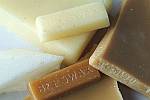 |
Creamy coloured encaustic
medium made from beeswax & damar resin, or whitish microcrystalline
or paraffin waxes, natural yellow beeswax or encaustic medium made
using this or perhaps with carnauba added, they all offer natural
colouring. However, these colourings will be affected both by time and
by light, so are not stable. They can be used interestingly if photographic
record or changing artwork fits your need. If
not, then scroll on down the page! |
|
Encaustic Art Wax Blocks The pigments are as light-fast as possible yet still meet the strict toxic controls demanded and implemented in the USA. They are labeled with the CL health label (caution label) which means that the waxes are safe in content but care needs to be observed when using them with the heated tools, simply because these heated implements might inflict light burns if carelessly handled. The waxes themselves are considered and tested as safe, making them suitable for ALL user groups. The encaustic Art Wax Blocks come in 48 colours with most of the darker hues tending to give a thicker & more viscous consistency when molten ( around 65 degrees Celsius). The lighter colours tend to be more liquid although this is not a strict characteristic. These alternative viscosities within the range allow for interesting interaction between the differing waxes. Pleasing and effective combinations are easily discovered. All colours are totally intermixable. These waxes can
be polished when the artwork is finished or for greeting cards and
such like they can be varnished over with the wax sealer, which will
keep their sheen and also affords protection
from light abrasions e.g. finger marks. Generally, unless it
is necessary , it is better to leave the encaustic art waxes in a polished
state rather than to seal them. This allows future work to be done and also allows
further polishing through time. The pure wax
surface is probably far more durable than the acrylic sealer that
is often used to varnish over for greetings card artworks, etc. |
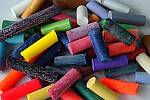 |
Hobbyring wax sticks hail from Germany. Their manufacturing base has changed with time, so the example sticks shown here may not reflect their current production products. The colour range is broad, with some bright and fantasy colour included too. The consistency of these waxes vary's slightly with the particular colours. |
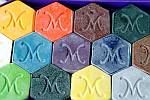 |
Vargamari hexagonal encaustic waxes developed from a lady wanting her own encaustic paints in Hungary. Their interesting shape reflects the beeswax that composes a large part of their composition. The blooming is a signal that the beeswax is there. The colours are less dense than in some other brands. |
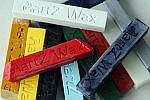 |
AartZ Wax was a UK manufactured brand, now discontinued. The colours were strong and the composition included polyethylene wax which was used to raise the melt point. One issue arose during development that proved "silicone rubber molds" were unsuitable for wax casting. The silicone leeches out into the surface wax and when applied in artwork this alters the surface tensions in the wax to form "fish-eye" which resembles myriad small white spots appearing out of nowhere when the wax is spread onto card. |
 Up to Index |
Mala waxes are one of a multitude of brands of children's crayons available across the world. These crayons are often made from paraffin wax to keep costs down. As a wax colouring product applied by abrasion the paraffin works well. However, in molten use this type of product can be very liquid, almost watery. Also the colours are often strengthened with dyes, so are not to be trusted for longevity as fading can occur. |
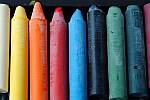 |
Lyra waxes are another brand of European make that offer different qualities for encaustic work. These are quite syrupy to use, having a thick viscosity when molten. This is good for textural effects on cards and the like. Not sure about the colour durability, but the range is pleasing although more limited than the leading brand. |
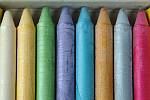 |
More Lyra wax sticks, this time in fantasy tones. These are probably mixed with mica which has a pearly reflective quality. Several other ranges include this material in the waxes. For instance the encaustic art blocks have a "pearlescent" colour which is a mica in wax which can be used to add a "shimmer" quality to any other colour. |
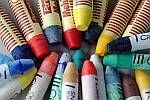 |
Crearte beeswax sticks are from Finland. Another example of a cross-over between the children's crayon market and artistic wax medium resources. The samples we had were like molten lipstick, thick and creamy. The bloom is apparent on these old samples. The colour range involved mostly opaque pigments. |
 Up to Index |
Caran D'Ache Wax Oil crayons are popular for their rich colours. These Swiss originating products can be melted and used within encaustic work. They can be mixed into other encaustic medium too, thus changing their handling and usefulness. The colour range is designed for artists and is based on opaque pigments. |
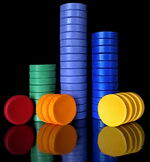 |
Enkaustikos manufactures a full color range of professional encaustic wax paints with over 80 colors and is one the leading USA brands. These encaustic paints are manufactured with artist grade pigments, damar resin, and United States Pharmaceutical Grade (USP) Refined Natural Beeswax. Enkaustikos is the only company that uses pharmaceutical grade beeswax making their wax paints chemical and bleach free. They utilize a high-tech mill that is capable of shearing pigment particles to their smallest particle size making their colors rich, intense, creamy, clean, and vibrant. |
 |
RFPaints encaustics produce a fine art commercially made encaustic medium colour. Specifically for artists in professional mode. They are the other leading USA company. The colours are vibrant and mostly opaque in the samples we have used. |
 |
RFPaints pigment sticks are a rich pigment in oil, designed by them for use within encaustic work as well as in their own right. Rich & vibrant colour! These are not actually waxes although it seems that there is some wax content. Highly durable. |
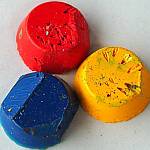 Up to Index |
Self made, Studio made, Home
made. This is the type of resultant wax paint that you
will get by combining encaustic medium and pigment colour in your own
making process. The main qualities of the final wax will be determined
by the wax formulation and pigment types used. Some ingredients would
yield translucent colours whilst others make strong surface reflecting
opaque ones. See the recipes page for an outline on how to make medium, and look at the adding colours page to see how to colour the wax in small amounts. Also note the overview and cautions information please. |
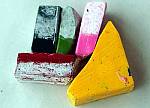 |
Dehan waxes are a UK based Hobby Wax. These example pieces are quite old but show the issue of bloom very clearly. You can see how the colour of the wax is present under the bloom and has been revealed by buffing with a soft tissue a few times. These waxes have a syrupy consistency and general translucency for use particularly with stamps and black silhouette stickers work. |
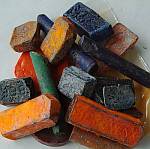 |
Candle DYES are not lightfast colours. They will fade through time. They also migrate through the wax, so can bleed and blur hard edge lines. But despite all that, they can give some wonderfully vibrant yet translucent colourings and can stain the support during use too. All these effects might be used to advantage so long as one realises the transient nature of the results. They will change through time, but then, is there anything that is really permanent or is permanence just a loose term relating to lengths of human lifetime? Investors want it anyway! |
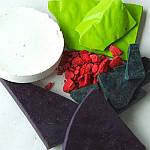 |
Candle pigments are stronger than the dyes and you will need to refer to specific product to see how lightfast it is deemed. Often these pigments are designed to be used as outer dips for candle colouration. This means that they will not enter the wick, so need not burn. The colours can be very strong, especially when used in their concentrated form. The examples shown here are very finely milled so the pigment particles are very fine. |
| Up to Index | For more on encaustic wax colours search the web! |
|